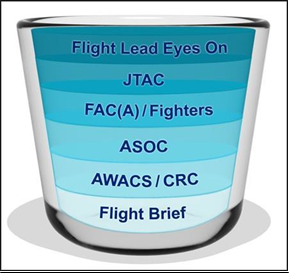6.6 Theater Air Control System.
6.6 Theater Air Control System.
The TACS provides the commander the capability to plan and conduct joint air operations. The purpose of this document is to provide an introduction to TACS for the pilot and not to build a complete command and control (C2) system. There are many facets to TACS, but this document will focus on information gathering from the pilot’s perspective in the jet, and specifically to the IFF syllabus. For an indepth reading on TACS, reference Joint Publication 3-09.3, Close Air Support, Chapter II.
Information gathering for a SAT sortie will begin in the brief. Performing thorough map study and having a working knowledge of the scenario will lessen confusion airborne. Normal premission planning cannot be overstressed. This is the start of what is known as “filling your SA cup.” (Figure 6.1.)
6.6.1 AWACS/Control and Reporting Center (CRC).
The AWACS is an airborne platform designed to provide the air picture to the war fighters. The CRC is the same type of system but is based on the ground. Both can provide almost the same information. When checking in with them, your flight lead or you, if so tasked, will provide them with the following information: call sign, mission number, and position relative to bull’s-eye (B/E). Expect that they will want to authenticate you with a known code. Information that is provided to you is a sweet-and-sour check of your IFF/selective identification feature (SIF) system (covered more in your MDS) and the picture of the airspace. They can provide you status of tankers, fighters and other players in the area of operations (AO) as well.
6.6.2 Air Support Operations Center (ASOC).
The ASOC is the focal point for all the Army ground requests for air support. The Navy and Marines also have a similar unit. When you contact the ASOC, you will provide them with call sign and mission number. Once again, expect authentication procedures. They should provide you with an AO update consisting of: threats, targets, friendlies, artillery, clearance authority, and possibly target area weather. They should also give you the call sign and frequency of the forward air controllers (airborne) (FAC(A)) or joint terminal attack controllers (JTAC) in your assigned area of responsibility (AOR). During the SAT phase, you may not get all of this information due to training limitations. The ASOC is also where you will provide an in-flight report upon exiting the AO. The in-flight report consists of: call sign, mission number, location (coordinates), time on target, results, and any other remarks (for example, weather, threats, significant sightings).
6.6.3 FAC(A)/Fighters.
Once in the AO and if present, your flight will contact the FAC(A) or the fighters that are leaving before you. You can always ask them for any updates to the AO. Usually, these players will have good SA and information about your AOR. If a FAC(A) is present, expect to work with him throughout your AO time slot.
6.6.4 JTACs.
JTACs are enlisted Air Force personnel assigned to work with the Army. They are trained much like an FAC(A) on how to control air assets from the ground in order to destroy targets. They are on the front lines putting eyes on targets that the ground commander wants or needs destroyed. They will generally have the highest SA on what targets need to be hit. However, they can have limitations due to their positions on the ground such as radio LOS, visual LOS to targets, etc. During SAT training, you will likely not talk to or have a simulated JTAC. Having a JTAC on the ground in your scenario generally implies that there are other friendly forces in the area. This situation requires detailed coordination with ground forces in order to safely affect the battlespace. Employment in this situation is called CAS and beyond the scope of this chapter.
6.6.5 Flight Lead Eyes On.
Finally, once the flight is established in the AOR, the flight should have all the pertinent data with respect to Threats, Targets, Friendlies, Artillery and Clearance (TTFAC). He can now use all the data gained through the TACS coord and compare it with what the flight is seeing on the ground. With that information, the flight lead can make an informed decision on how best to maximize the flight’s mutual support to achieve the desired effects of the battle space.


No comments to display
No comments to display